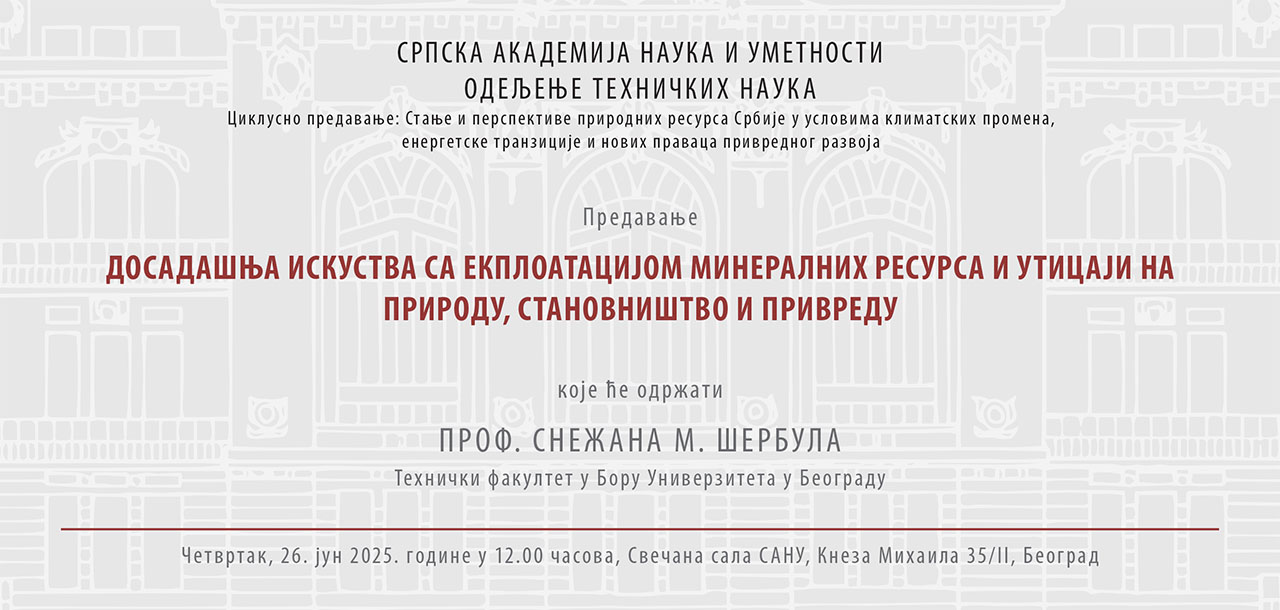Lecture ’Recent Experiences with Mineral Resources Exploitation and the Impact on Nature, Population and Economy’ by Professor Snežana M. Šerbula, PhD
As part of the lecture series ’Current State and Perspectives of Natural Resources of Serbia in the Era of Climate Change, Energy Transition and New Directions of Economic Development’, Professor Snežana M. Šerbula, PhD, will give a lecture titled ’Recent Experiences with Mineral Resources Exploitation and the Impact on Nature, Population and Economy’ on Thursday, 26 June, at noon, at the SASA Grand Hall.
Bor and its vicinity have been sites of exploitation and copper sulfide ore processing for over 100 years. Continuous ore exploitation in the studied area has had a detrimental effect on the environment. The town of Bor has developed alongside copper mining and metallurgical industries. Environmental quality measurement points are located in urban-industrial, suburban and rural areas, positioned according to the directions of dominant wind, variously scattered from the pollution source. Long-term monitoring data show elevated concentrations of heavy metals such as arsenic, lead, cadmium, copper, and zinc in airborne particles and atmospheric deposition. Arsenic levels in particular have consistently exceeded permitted values, at times reaching up to 100 times the legal limit. The presence of sulfur dioxide in the air has resulted in acid rain and the accumulation of sulfates in atmospheric sediments.
Surface watercourses in the Bor region vary across all water categories, from one to five. Water quality monitoring indicates that heavy metals and arsenic are leached from overburden and ore in open-pit mines due to atmospheric precipitation, while acidic mine waters are discharged directly into these watercourses. Natural water quantities in watercourses are insufficient to meet the large demands of mining companies for the production of ore concentrates. Therefore, artificial lakes are used, and there is a possibility of using potable water sources for industrial needs. Vegetation demonstrates a direct response to the state of air, water, and soil. High concentrations of heavy metals have been determined in the underground and above-ground parts of plants. The surface and underground soil layers surrounding the studied plants reflect the cumulative presence of environmental pollutants. The bioaccumulation of hazardous substances in wild deciduous and evergreen species—used in the diet of animals and humans—has also been examined.
Professor Snežana M. Šerbula, PhD, is a full professor at the University of Belgrade Technical Faculty in Bor. She graduated from the Technological Faculty in Bor, where she also obtained her Master’s Degree and defended her doctoral dissertation.
Her academic and professional focus spans environmental protection, as well as chemical, electrochemical, and technical engineering. She has authored four textbooks, edited two monographs, and written 15 chapters in internationally recognised academic volumes. Her publication record includes 47 peer-reviewed papers—28 published internationally and 19 domestically—along with 68 presentations at international symposia and 38 at national ones. She has delivered eight invited lectures and taken part in 21 projects or studies. According to the SCOPUS citation index, her work has been cited 1,157 times in 901 documents, with an H-index of 18.

